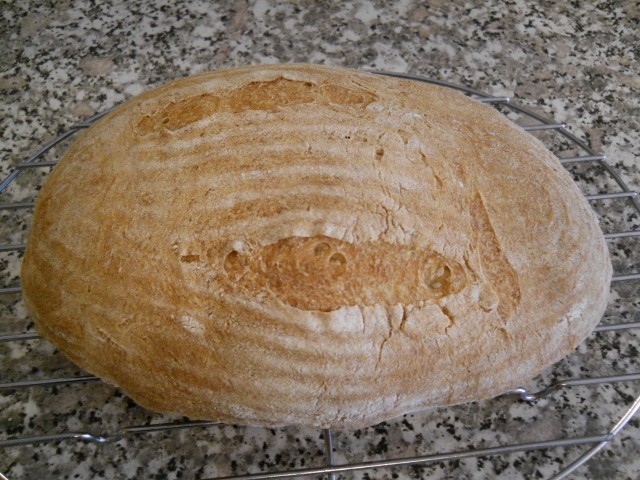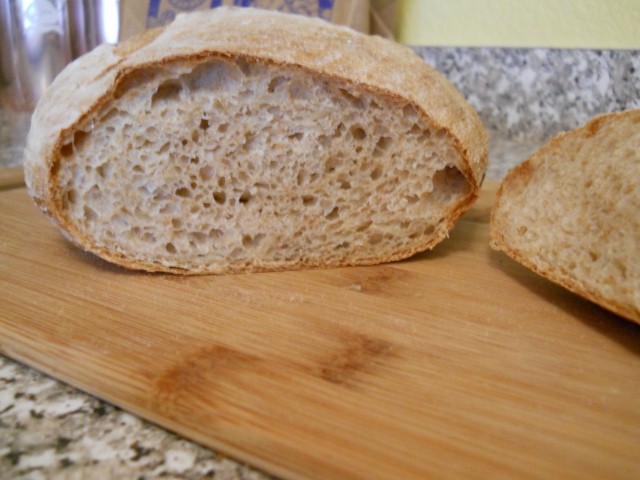I am very new to baking bread, and I have some questions! Bear with the strange mixing of measurements, I am still trying to get the hang of weight vs. volumn.
I am using the first recipe in Floyd's book, and am tweaking it a bit:
Poolish: 30 grams whole wheat flour, 1/8 tsp. instant yeast, 1/4 water - let sit overnight
Dough: 225 grams AP flour, 45 grams whole wheat flour, 1 tsp sugar, 3/4 + 1/8 tsp instant yeast, 3/4 cup of flour - mix and let autolyse 30 min. Mix in the poolish and 1 1/2 tsp kosher salt. I was using my KA to knead the first few loaves of bread that I made, but decided I was missing out on the fun of having my hands in there, so I have been using the french flold technique to knead. I have found that I have to keep my hands very wet while doing the french fold and while the dough does get stretchy and sort of smooth, there are still little tears/blisters in the dough. Is this right? The dough does not behave like this using just AP flour, but the addition of the WW seems to really change things up. What should the dough feel and look like?
Now onto the stretch and fold questions: How many times do you do it? I have read that you just do it once every 30 minutes during bult ferment, I have read that you do it 6 or 7 times every 30 minutes. Whats up with that?? Is that the difference from making bread with commercial yeast vs. natural yeast? The more I read, the more confusing things get.
Onto crust: why does it blister? The bread made with AP flour did not have surface blisters, yet the bread with some WW in does. Is it the flour or my techniques?
Thanks for any help that folks can give me.
Okay, I baked and here is what it looks like, ugly but tasty.
The blisters are there on the crust again - next shot is the crumb

Looks pretty good, nice job!
Usually anywhere from 4-7 times every 30 minutes after your initial mix of the ingredients. This helps build dough strength in a very gentle but effective way, and is done in lieu of kneading (or sometimes to supplement kneading). Works well for wet doughs. If you use it in lieu of kneading, it will be 4 S&F's or more before you can feel the dough really becoming strong and elastic. You can use the S&F technique with commercial or natural leavening, works well in both cases. Does that help?
Maybe it's the photo quality, I don't see any blisters in your photos, I do see 3 scores (or perhaps they are rips). Scoring is done to enable controlled dough expansion when it bakes. Rips occur when the expanding dough tries to find the path of least resistance; this is why scoring help control how the final bread looks. Rips can also occur when the dough isn't sufficiently developed.
Blisters, on the other hand, usually look like...blisters :) They often happen when you have long, slow, cold fermentation.
So, if I am understanding this, if you mix everything together, and then let it sit like that and do periodic s&f, kneading or french fold is not needed. A lot of s&f's are taking the place of kneading/french fold?
I also see the difference in what I thought were blisters and what are blisters. I think what I see on my crust might be air bubbles popping during oven spring.
Yes, exactly.
Hmm...do you think you could post another photo of your bread and point out the blisters that you see?
What I was calling blisters are the small, round holes that you can see in the split from scoring. I am just a beginner, just started baking bread this month, so I do not have all the lingo down yet.
Regarding kneading vs. not kneading, is there a reason to use one meathod over another? I have found with the dough that I am using is very soft, so actual kneading does not work. The french fold does, as long as I keep my hands wet the whole time. I think the next loaf that I do I am going to try just letting it sit, then some s&f's. I guess this is part of the learning curve that I have jump on with baking bread.
Cranbo, I really appreciate your insights - thanks!
Ah, OK, I see them. Nothing to be concerned about with those holes in the split. When you slash, you are cutting through the dough texture, and as you cut you weaken the dough at that point, thereby making it possible for the dough to rise (and potentially pop some of the gas bubbles that have formed near the crust during rising). Likely it happens in your WW bread because the dough is probably not as strong as the white dough, so weaker bubbles are more likely to pop than in white dough.
That's exactly one of the reasons: really wet doughs can be easier to handle in this manner. It's both a time-saver and flavor enhancer: in a very general way, less time spent handling the dough means a greater increases in flavor, to a point.